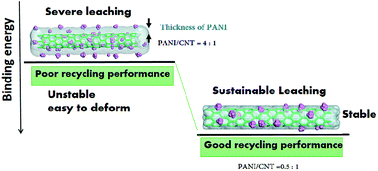当前位置:
X-MOL 学术
›
Catal. Sci. Technol.
›
论文详情
Our official English website, www.x-mol.net, welcomes your feedback! (Note: you will need to create a separate account there.)
Pd nanoparticles immobilized on carbon nanotubes with a polyaniline coaxial coating for the Heck reaction: coating thickness as the key factor influencing the efficiency and stability of the catalyst†
Catalysis Science & Technology ( IF 5 ) Pub Date : 2018-02-12 00:00:00 , DOI: 10.1039/c7cy02588b Rui Yu 1, 2, 3, 4, 5 , Rui Liu 1, 2, 3, 4, 5 , Jie Deng 5, 6, 7, 8 , Maofei Ran 5, 9, 10, 11 , Ning Wang 12, 13, 14, 15, 16 , Wei Chu 5, 17, 18, 19 , Zhiwei He 1, 2, 3, 4, 5 , Zheng Du 5, 20, 21 , Chengfa Jiang 5, 17, 18, 19 , Wenjing Sun 1, 2, 3, 4, 5
Catalysis Science & Technology ( IF 5 ) Pub Date : 2018-02-12 00:00:00 , DOI: 10.1039/c7cy02588b Rui Yu 1, 2, 3, 4, 5 , Rui Liu 1, 2, 3, 4, 5 , Jie Deng 5, 6, 7, 8 , Maofei Ran 5, 9, 10, 11 , Ning Wang 12, 13, 14, 15, 16 , Wei Chu 5, 17, 18, 19 , Zhiwei He 1, 2, 3, 4, 5 , Zheng Du 5, 20, 21 , Chengfa Jiang 5, 17, 18, 19 , Wenjing Sun 1, 2, 3, 4, 5
Affiliation

|
Pd nanoparticles (NPs) supported on polyaniline (PANI)-coated carbon nanotubes (CNTs) were synthesized using a low-cost and simple method for application in the Heck reaction. The effects of the PANI/CNT coating weight ratio on the catalytic stability and recyclability of the composite were determined by using a combination of experimental and computational methods. The results show that through coordination of the N-species in PANI with the Pd NPs, the nitrogen-rich PANI@CNT provides a strong support for the Pd NPs. The thickness of the PANI layer is the key in determining the stability of the catalyst. PANI becomes protonated in the presence of CNTs, as electron transfer from the former to the latter creates strong interactions between the two. Thus, PANI becomes more stable in nanocomposites with a higher CNT content, e.g., PANI/CNT = 0.5 : 1. The catalyst with a PANI/CNT ratio of 0.5 : 1 exhibited the best recycling performance, and only a small loss of activity was observed after 10 cycles. However, upon increasing the PANI content (e.g., PANI/CNT = 4 : 1), the PANI units tend to form bulk structures that are less stable than those that wrap around the CNTs. Such a structure is unstable; therefore, the PANI layers can easily deform or break away from the CNT backbones. Hence, these catalysts deactivate during recycling. Thus, our study demonstrates that the assembly of noble-metal NPs on CNTs bearing a thin coaxial PANI coating is a powerful technique to prepare reusable catalysts for the Heck reaction. Coating thickness is also a key factor affecting the efficiency and stability of the catalyst.
中文翻译:

钯纳米颗粒固定在具有聚苯胺同轴涂层的碳纳米管上用于Heck反应:涂层厚度是影响催化剂效率和稳定性的关键因素†
使用低成本,简单的方法合成了负载在聚苯胺(PANI)涂层的碳纳米管(CNT)上的钯纳米颗粒(NP),用于Heck反应。通过结合实验和计算方法确定了PANI / CNT涂层重量比对复合材料催化稳定性和可回收性的影响。结果表明,通过PANI中N物种与Pd NPs的协调,富氮PANI @ CNT为Pd NPs提供了有力的支持。PANI层的厚度是确定催化剂稳定性的关键。当电子从前者转移到后者时,PANI在CNT的存在下被质子化,从而在两者之间产生强相互作用。因此,PANI在具有更高CNT含量的纳米复合材料中变得更加稳定,例如,PANI / CNT = 0.5∶1。PANI / CNT比为0.5∶1的催化剂表现出最佳的再循环性能,并且在10个循环后仅观察到很小的活性损失。然而,随着PANI含量的增加(例如,PANI / CNT = 4:1),PANI单元倾向于形成比包裹在CNT周围的整体结构不稳定的整体结构。这样的结构是不稳定的。因此,PANI层很容易从CNT主链变形或脱离。因此,这些催化剂在再循环期间失活。因此,我们的研究表明,在带有薄同轴PANI涂层的CNT上组装贵金属NP是一种强大的技术,可用于制备可重复使用的Heck反应催化剂。涂层厚度也是影响催化剂效率和稳定性的关键因素。
更新日期:2018-02-12
中文翻译:

钯纳米颗粒固定在具有聚苯胺同轴涂层的碳纳米管上用于Heck反应:涂层厚度是影响催化剂效率和稳定性的关键因素†
使用低成本,简单的方法合成了负载在聚苯胺(PANI)涂层的碳纳米管(CNT)上的钯纳米颗粒(NP),用于Heck反应。通过结合实验和计算方法确定了PANI / CNT涂层重量比对复合材料催化稳定性和可回收性的影响。结果表明,通过PANI中N物种与Pd NPs的协调,富氮PANI @ CNT为Pd NPs提供了有力的支持。PANI层的厚度是确定催化剂稳定性的关键。当电子从前者转移到后者时,PANI在CNT的存在下被质子化,从而在两者之间产生强相互作用。因此,PANI在具有更高CNT含量的纳米复合材料中变得更加稳定,例如,PANI / CNT = 0.5∶1。PANI / CNT比为0.5∶1的催化剂表现出最佳的再循环性能,并且在10个循环后仅观察到很小的活性损失。然而,随着PANI含量的增加(例如,PANI / CNT = 4:1),PANI单元倾向于形成比包裹在CNT周围的整体结构不稳定的整体结构。这样的结构是不稳定的。因此,PANI层很容易从CNT主链变形或脱离。因此,这些催化剂在再循环期间失活。因此,我们的研究表明,在带有薄同轴PANI涂层的CNT上组装贵金属NP是一种强大的技术,可用于制备可重复使用的Heck反应催化剂。涂层厚度也是影响催化剂效率和稳定性的关键因素。


























 京公网安备 11010802027423号
京公网安备 11010802027423号